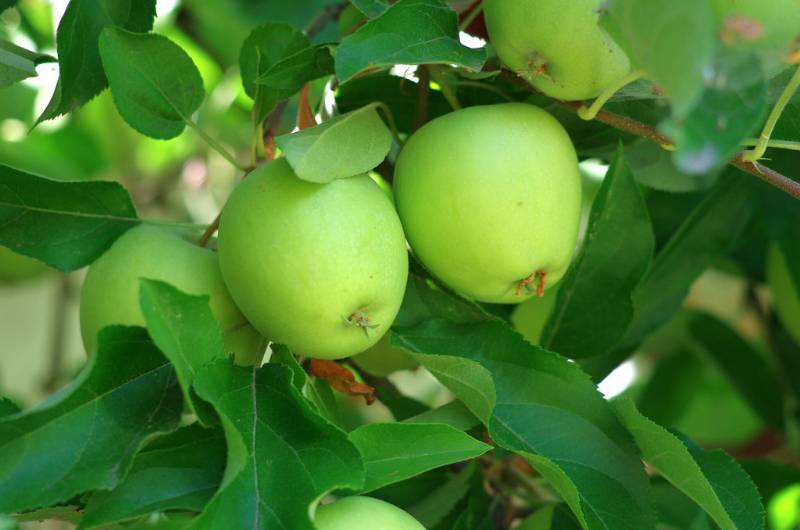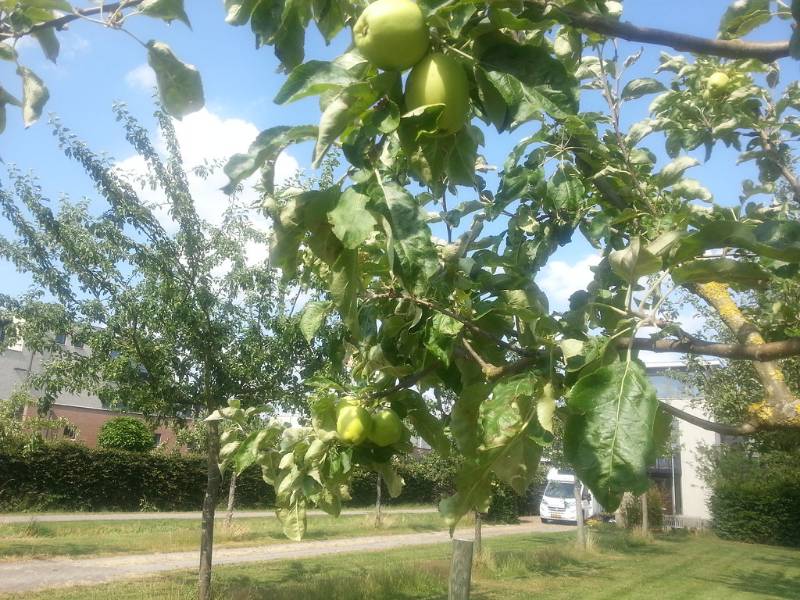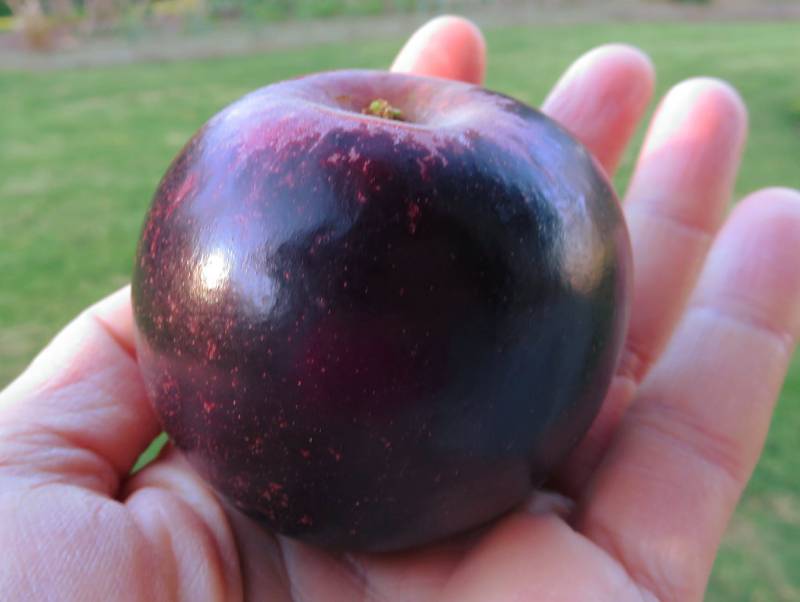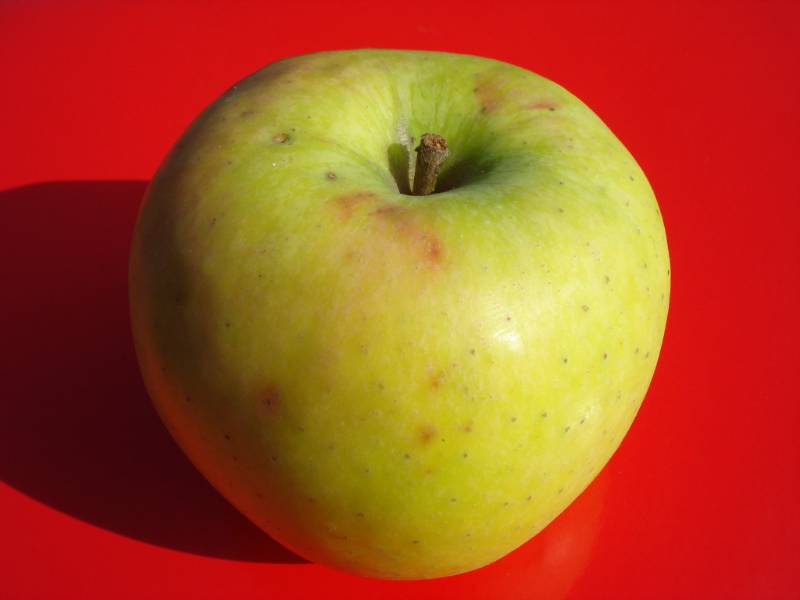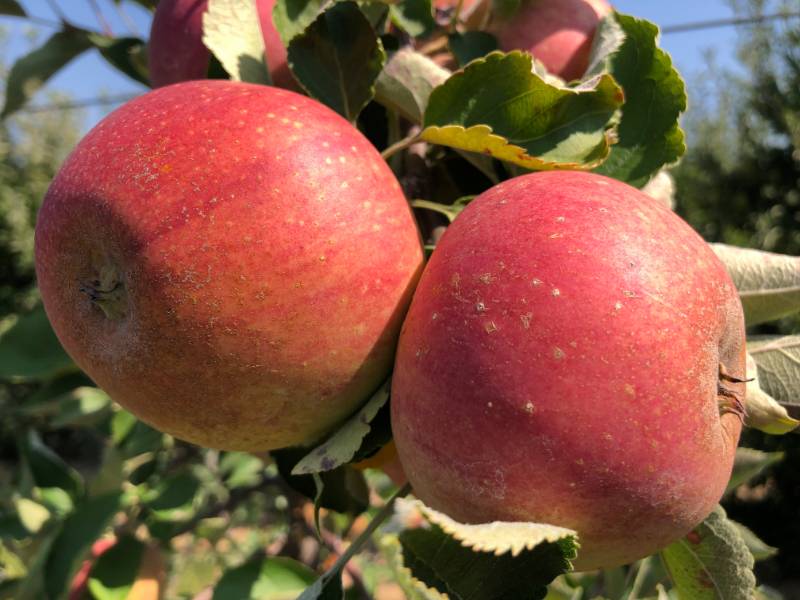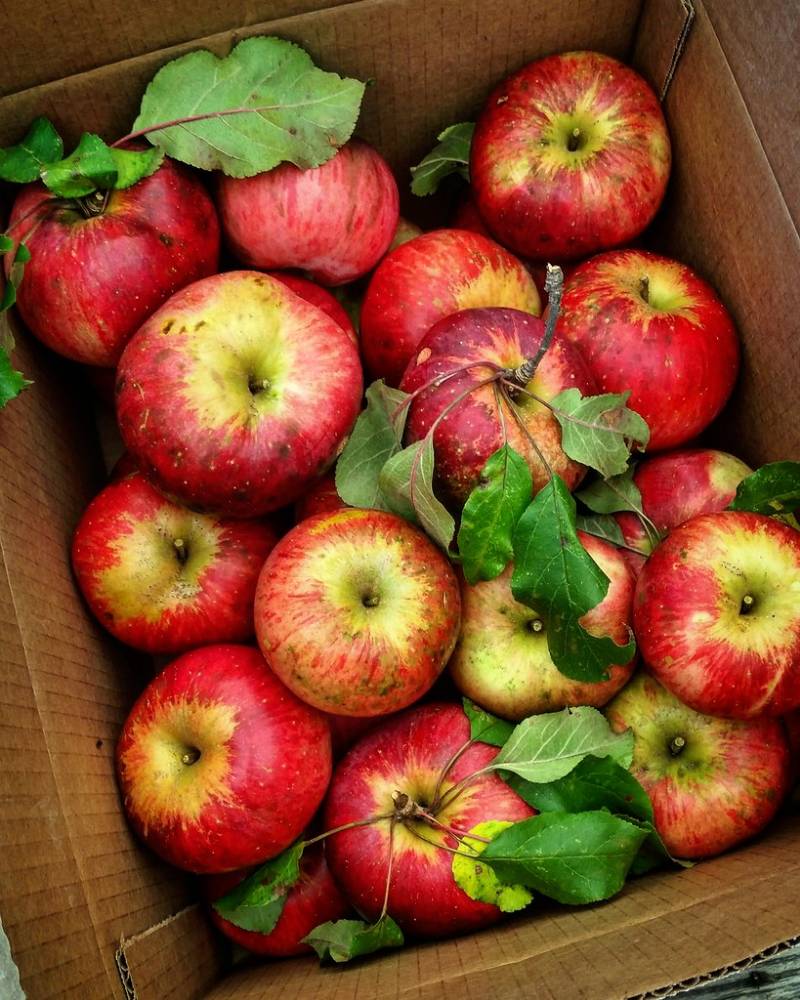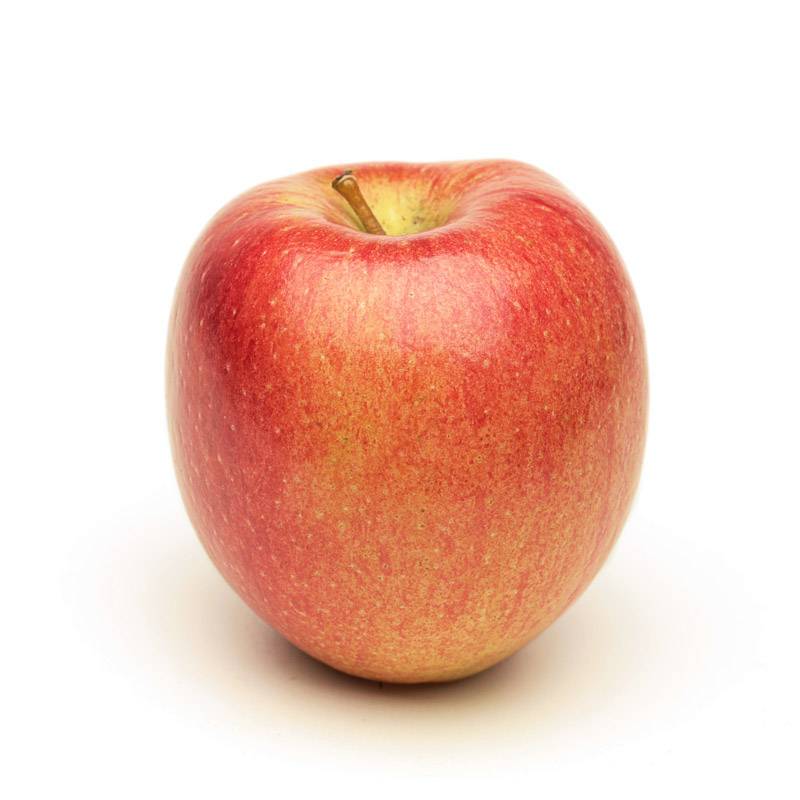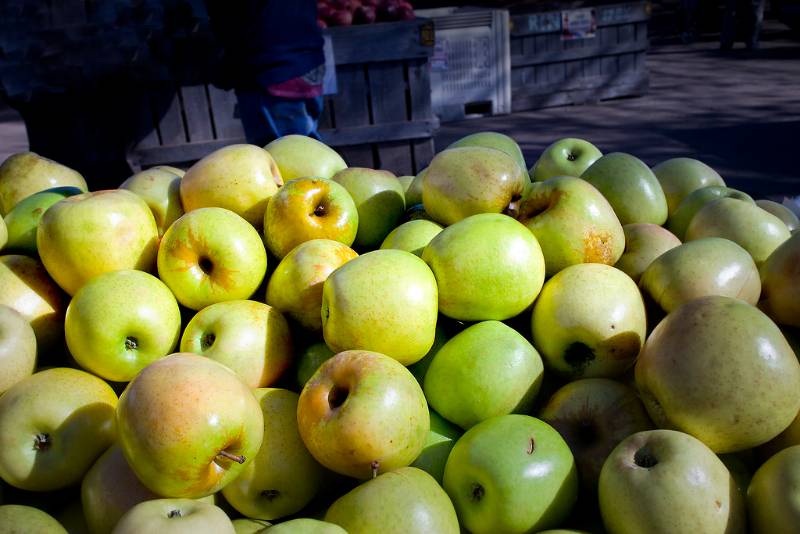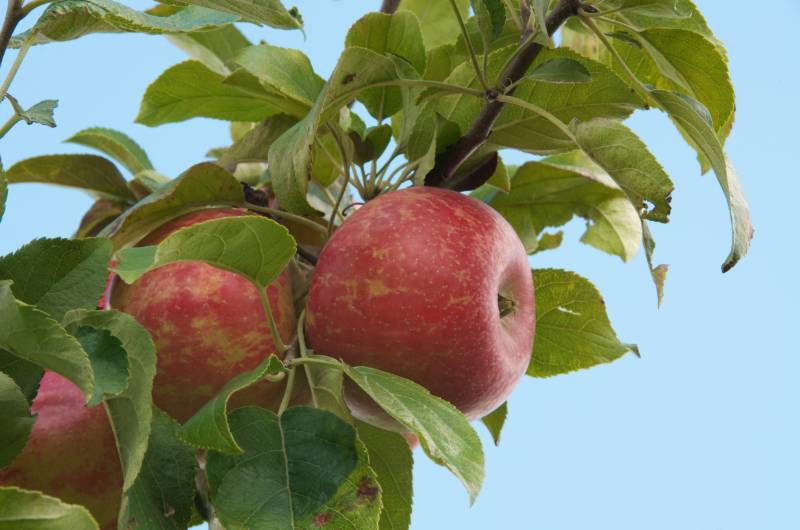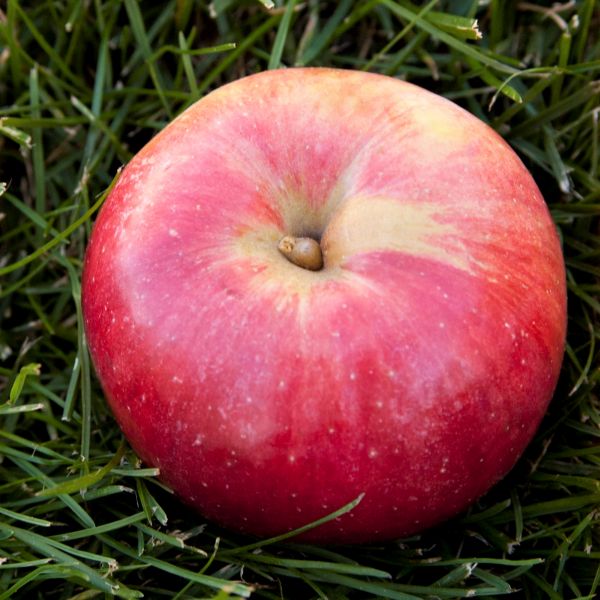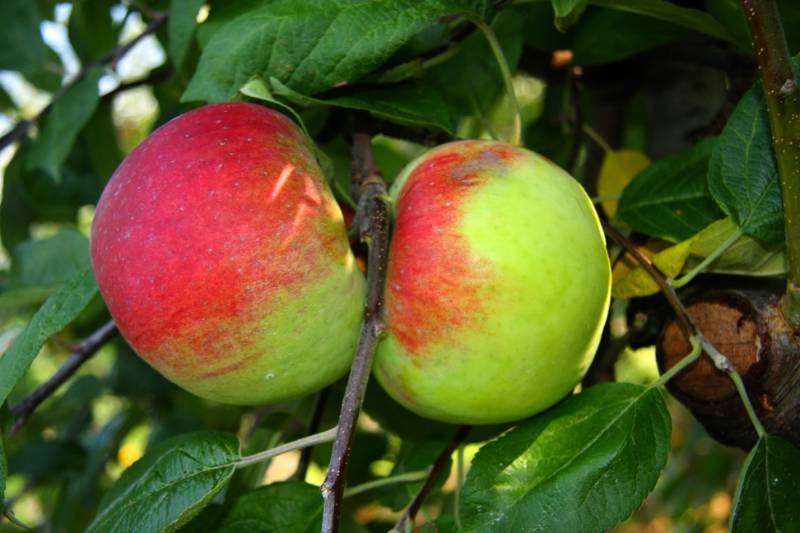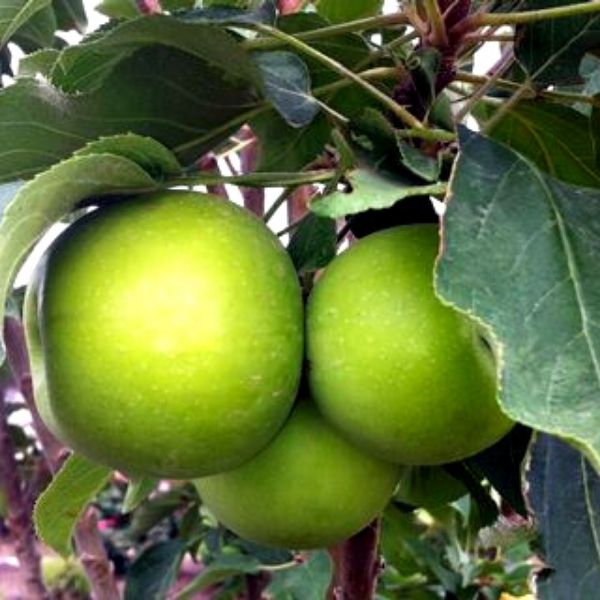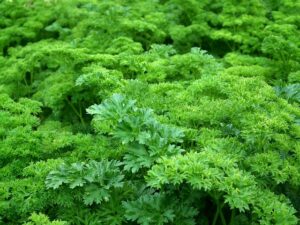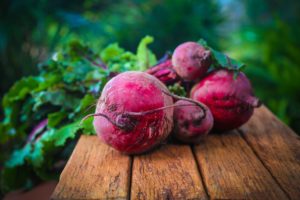On this page, you’ll find the best apple tree varieties that will produce a bountiful harvest of juicy crisp apples. With so many different types of apple trees, you’re sure to find one that’s perfect for both your soil conditions and your climate.
Apple Tree Varieties
Fuji Apple Tree
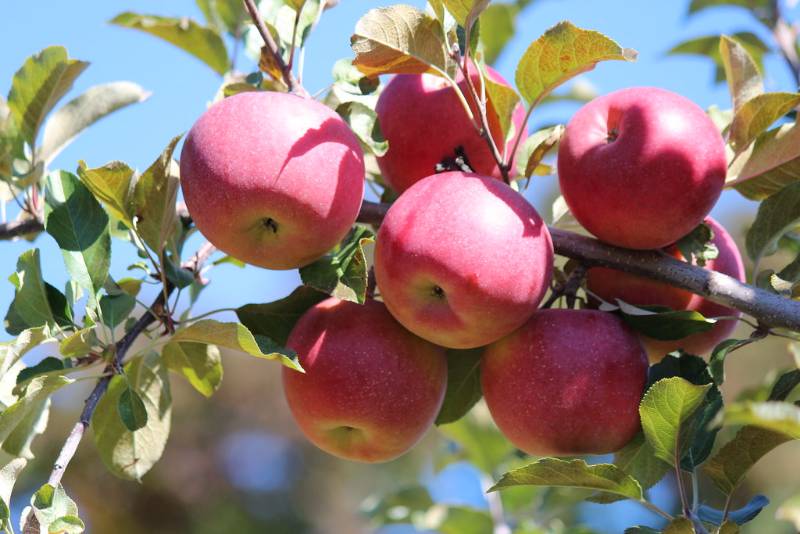
Fuji Apple Tree – (Buy Online)
The Fuji Apple Tree (Buy Online) delivers a spectacular spring display and produces fruit in an outstanding fall harvest. Ornamental and edible, this variety is a native of Japan. It makes a wonderful focal point in your sunny backyard orchard. A cross between the Red Delicious and the Virginia Ralls Genet, the refreshing flavor of the Fuji apple is prized.
It’s now one of the favorite apples in the United States. You’ll love that hearty crunch when you bite into a Fuji, followed by the succulent, sweet juice that naturally flows from the firm texture of the fruit. Fuji apples feature a wonderful dappled pink blush over a yellow-green fruit. They are well known for being juicy, crisp, and sweet.
McIntosh Apple Tree

McIntosh Apple Tree – (Buy Online)
The McIntosh Apple is famous not for its crunch, but rather its snap. From the first bite, the classic MacIntosh snap of the skin alerts you to prepare for the perfect blend of tartness to sugar that is so much the reason for its popularity.
McIntosh Apple trees produces heavy crops of small to medium-sized apples that ripen and are ready for harvest around mid-September. Often, McIntosh Apple crops persist into early winter, as this tree is hardy and can easily withstand colder temperatures. The tree is cold hardy, but it’s also adapted to a wide range of climates.
Red Delicious

Red Delicious Apple Tree – (Buy Online)
The Red Delicious apple is the most widely grown variety in the world. It’s a popular apple with a variety of uses. Red Delicious was the single largest variety produced in Washington State in 2005. Red Delicious has deep red skin and conical shape encasing flesh that is white and crisp, with a sweet flavor.
Red Delicious can grow to 12 feet tall with an equal spread, resulting in a relatively rounded crown and pleasing landscape appearance which can last up to 50 years. In the spring, clusters of small white flowers with subtle pink hues will adorn its branches with their fragrant elegance.
In the summer, dark green leaves adorn a rounded shape which turns a brilliant yellow in autumn, sprinkled with deep red fruit. It is truely a tree for all seasons.
The Red Delicious apple is a lovely ornamental tree that will provide you with a crop of delicious and nutritious fruit each fall. Our apple trees are always in high demand. Quantities are limited and many will sell out soon. Order now to avoid disappointment! * Deep Red Fruit * Sweet, Crisp, White Flesh* Color Throughout the Year * Recommended pollinators: Braeburn, Fuji, Gala & Honeycrisp
Cox Orange Pippin

Cox Orange Pippin Apple Tree – (Buy Online)
Cox Orange Pippin, Malus domestica ‘Cox Orange Pippin’, is the classic English apple, often regarded as the finest of all dessert apples, and it remains unsurpassed for its richness and complexity of flavor.
Cox Orange Pippin has a striking and attractive orange-red coloring and is definitely a superb looking and extremely tasty apple. Its medium-sized fruit has yellow skin blushed with orange-red and striped with crimson brown.
The Cox Orange Pippin apple is grown for cider, cooking, and eating. The fine-textured, creamy white flesh ripens mid-fall to early winter and will not tolerate extreme cold, heat or low humidity.
This upright, spreading tree is covered in pure white, cup-shaped flowers in mid and late spring, followed by first-class, juicy dessert apples for harvesting in early to mid-October.* Medium Yellow Fruit With Orange Red Blush* Excellent Dessert Apple* Rich Flavor Recommended pollinators: Fuji, Granny Smith, Honeycrisp
Red Jonathan Apple Tree

Red Jonathan Apple Tree – (Buy Online)
Jonathan Apple (Malus domestica ‘Jonathan’) is a deciduous tree producing one of the most sought-after heritage apples. Also known as the Red Jonathan, you can plant several in a side yard for your own garden-sized orchard of healthy fruit today!
Sometime during the 18th century, the Jonathan Apple quickly became one of the most popular American apples to grow. This was both for its adaptability and flavor, not to mention its popularity for years in apple hybridization.
Jonathan is a parent to many popular varieties that you may have heard of! Apples such as Jonagold, Jonamac, Idared, Melrose, and Akane, just to name a few. One of the many great things about apple trees is that they’re not only easy to grow and produce delicious fruit, but they’re also quite decorative… and Jonathan is no exception.
Wealthy Apple

Wealthy Apple Tree – (Buy Online)
The Wealthy Apple, Malus ‘Wealthy’, is a very juicy apple, with a tart and sweet strawberry-like flavor. It was one of the first high-quality apple varieties grown commercially. It is now often grown by backyard orchardists. The Wealthy Apple is known for its intense pink and white springtime blooms. The long bloom period makes the Wealthy Apple tree a great pollinator of other apple trees.
This is a multi-purpose apple, but it is especially good for cooking, such as pies, sauces, and juices. Wealthy often bears fruit the first year and keeps well. Its fruit tends to drop at maturity. The apples mature earlier than other varieties, usually starting in September. It is very cold hardy & has good resistance to apple scab, fire blight, and apple cedar. People often rate Wealthy Apple as their favorite. Plant them in your yard and you’ll soon discover why! Very juicy Heavy blooming Great pollinator
Dorsett Golden Apple
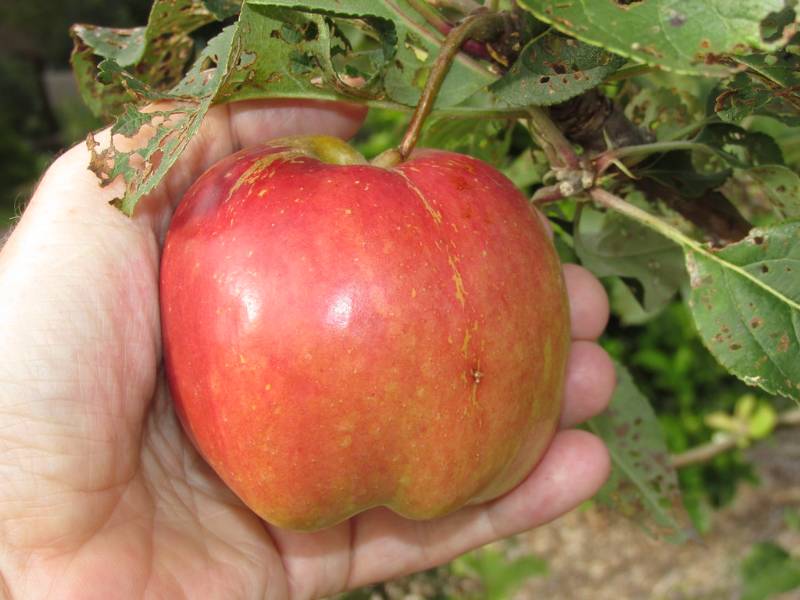
Dorsett Golden Apple Tree – (Buy Online)
Dorsett Golden Apple (Malus domestica ‘Dorsett Golden’), was first developed in the Bahamas in the 1950s and is well-suited to warm climates. It is popular with growers in Zone 8 – 9, as its one of the few low-chill apples that require less than 100 chilling hours for a successful harvest. From a purely aesthetic viewpoint, the Dorsett Golden Apple brings ornamental beauty to your lawn. Each spring, the Dorsett becomes blanketed in pink-tinged white blossoms that welcome in the season and send a call out to butterflies and hummingbirds.
Those blooms quickly transform with the passage of time into orbs of golden fruit with a delectable flavor. The Dorsett Golden Apple bears fruit that’s medium to large, which is perfect for fresh-eating apples since they’re not too small nor too big. The apples have a green-tinted yellow skin with a bit of rosy to scarlet blush that marks their time spent worshiping the sun while they mature. When set against the vibrant green foliage of the tree, these beautiful apples create a show all by themselves, much to the delight of both growers and passersby.
Granny Smith
The Granny Smith Apple tree is a fruit tree that produces high-quality, tart apples on a reliable tree. Plant one in a sunny location and watch your harvest grow! One of the best-known apple varieties for both cooking and snacking, Granny Smith enjoys a long history of being an apple with exceptional qualities. Its lovely, green skin (occasionally with a subtle, pink blush), presents a vibrant sight amid the branches in October.
The juicy, white flesh is likewise energizing, with a crisp, tart flavor that’s perfect for award-winning pies, culinary dishes…or just right off the tree. Granny Smith apple’s high acid content means that they won’t go brown as quickly once cut, so they’re especially valued for fruit trays and salads. Granny Smith apples are also chocked full of vitamins and antioxidants, but not calories, so they’re a great way to encourage good health.
Anna Apple
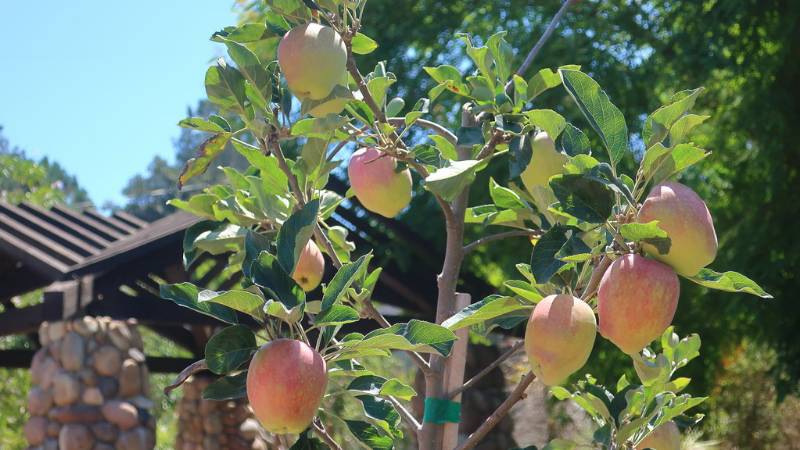
Anna Apple Tree – (Buy Online)
Apple-loving homeowners on the West Coast, and in the South need to know about Anna Apple tree (Malus Anna’). Anna requires only 200 hours of chill time, which makes it ideal for warmer climates. As you know, it’s always best to select varieties that do best in your area. Finding a good Apple tree for warmer regions can be tough, but Anna fits that profile. You’ll enjoy crisp, flavorful apples early in the season. Use them for snacking, baking, and juicing.
The fruit of the Anna Apple tree stores for up to two months, depending on your storage method. This tree is self-pollinating, so you’ll get a nice harvest from a single tree. However, if your trees are planted with a partner, they’ll get cross-pollinated. You’ll get a whole lot more apples! Anna is a prolific producer, and the harvest starts early in the summer. This makes a welcome addition to backyard orchards that already have later-bearing varieties. The petite, pink-tinted springtime blossoms are very fragrant.
You’ll have plenty of hummingbirds and butterflies come for a visit. Enjoy watching your developing harvest of fruit. Anna fruit features yellow skin with a fiery red blush upon ripening. This multi-use apple is sweet, with a tartness that makes for wonderful fresh eating, juicing, and baking. In its early stages, Anna has been compared to a Grammy Smith. However, during the apple ripening season, Anna increases in sweetness. Early to flower, the Anna Apple tree bears fruit early, too. It won’t make you wait long before you’re enjoying your very own, homegrown fruit.
Pink Lady
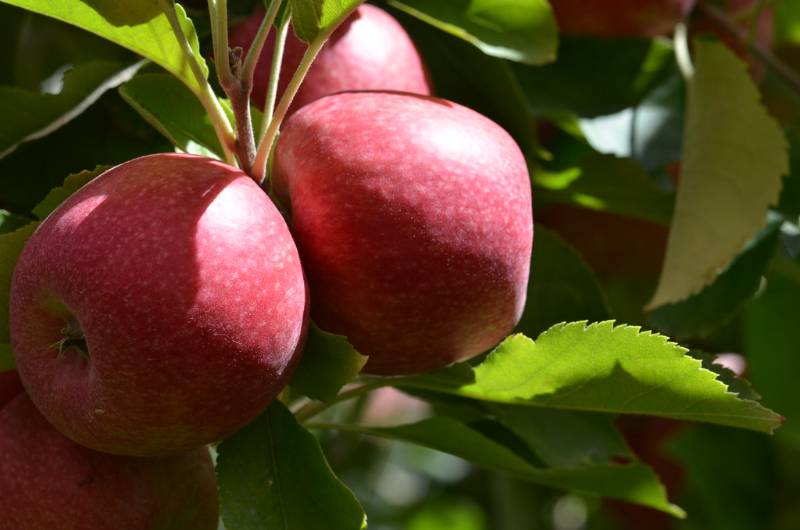
Pink Lady Apple Tree (Cripps Pink Variety)
Lady Apple trees, Malus domestica ‘Pink Lady’, have a distinctive fuchsia blush that dominates the yellow background of this superbly-beautiful apple. Clothed in this magnificent coloring, Pink Lady invariably creates a head-turning effect when it’s ripe for harvest. These medium/large apples are firm and aromatic, with what some say is a fragrance of pear or cider. When you approach the tree you’ll be astonished by their beauty, but that’s nothing compared to what you’ll experience when you reach out and pick one.
Biting into the yellow-tinted, white flesh will create a flavor explosion. Crisp and juicy, Pink Lady’s flavor is that of an apple, but with a distinctive taste of melon and just a hint of citrus. A subtle dash of tartness gives it just enough zing to tantalize your taste buds and make you yearn for the next bite. One of the best features of your Pink Lady Apple tree is that although delicious right off the tree, it improves in flavor after about four weeks in storage (and its storage life is very long).
Its adorable pink-accented, white flowers in spring are fragrant, long-lasting, and certain to draw pollinators to your yard. The fruit ripens in October/November, extending your joy of harvest time when other fruits have completed their season. With so many varieties of apple on the market today, it can be difficult to know which ones to grow. Pink Lady Apple trees offer not only superior flavor but great storage so you can enjoy your delectable fruit for longer. Add in the fragrance and beauty of this variety, and you can see why Pink Lady is a good choice in an apple tree for your home.
Pink Pearl

Pink Pearl Apple Tree -(Buy Online)
A Pink Fleshed Apple! The Apple – Pink Pearl, Malus domestica ‘Pink Pearl’, is an heirloom variety of apple that is generally medium-sized, with a conical shape. Pink Pearl has a translucent, yellow-green skin, and a crisp, juicy, pink flesh with tart to a sweet-tart taste of raspberries and lemon custard.
This is an early blooming apple that needs a pollinator such as Jonathan and/or Red Astrachan. Pink Pearl apples ripen in late August to mid-September. It is a wonderful table apple and makes beautiful pink applesauce, is great for fresh eating, pies, chutney, baking, applesauce, and stores well.
Macoun Apple
Macoun Apples are commonly found at roadside stands and fruit markets. They are famous for their delicious dessert qualities. Fragrant, great texture and a complex mix of spicy, sweet, and tart make them a real favorite. Macoun Apples are in high demand as products sold at roadside stands and pick-your-own orchards; now, you can grow your very own in your backyard. Wonderful fresh eating apples, you can use them in salads and fruit cups Macoun also stands up to baking and remains firm.
The Macoun Apple tree itself grows upright and blooms late midseason. It’s a great pollinator partner for other apples, and pollinate early blooming Apple trees, as well as ones blooming mid-season and late in the season. Though the tree is adaptable and can thrive in many soil types, your planting site will need to have good air circulation, well-drained soil, and full sunlight.
Gravenstein Apple
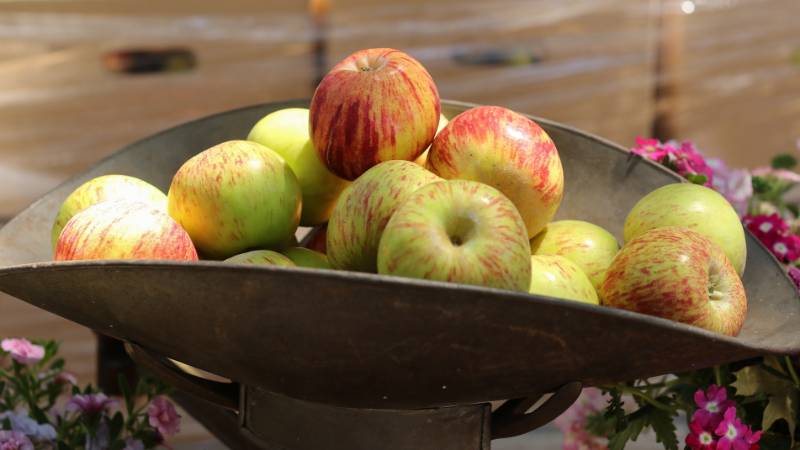
Gravenstein Apple Tree – (Buy Online)
The Gravenstein Apple originated in Denmark in the early 1600s, where it is called a native and is proclaimed as the “National Apple”. This wonderful fruit was so admired that it was brought to the United States with Russian settlers in the early 1800s, with orchards being established at Fort Ross, California. The Gravenstein Apple was immediately recognized as a uniquely superior fruit with its adaptability, many usages, and wonderful flavor.
The local orchards of Sonoma County California would become the central distribution point for the Gravenstein Apple. Nathaniel Griffith, called the Grandfather of the Gravenstein, was encouraged by none other than Luther Burbank to plant, what Burbank considered, a most superior apple.
Firm, snappy, light green with red stripes and a wonderfully distinctive flavor. Gravenstein Apple has an excellent tart-sweet flavor and is famous for making the finest apple juice and ciders. Gallons of pure pressed Gravenstein Apple Juice is still in high demand today.
Wonderful as dried fruit, in the early 1900s no less than 100 driers existed in the Sonoma County of California to satisfy the demand for this wonderful dried fruit.
.It’s widely adapted to many climates and is known to produce in the colder zones 2 to 4. It may however experience damage in years of early extreme temperature swings in these zones. This may make the “Grav”, as it is known, one of the most widely adapted of all apples. The adaptability extends into the more common apple-growing regions of zones 5 – 9, where it is primarily grown by farmers market growers and home gardeners.
Yellow Transparent Apple
The Yellow Transparent Apple Tree is a deciduous, fruit-producing tree that was imported from Russia in 1870 and is widely grown in the northern states. Plant one in your backyard where it will be visible from a patio or window so you can enjoy watching your harvest grow. The Yellow Transparent Apple Tree is a true delight, with yellow-hued bark, and pink or white flowers appearing in early spring. It’s not long before the apples follow, their skin a clear yellow-green to yellow-white amid the lush, green foliage.
The flesh of the Yellow Transparent Apple is tender white, with a juicy and mildly-acidic flavor that makes it a favorite for homemade applesauce and other culinary delights. Yellow Transparent will provide you with an early harvest, the apples ripening in early July, so it’s a great choice to plant amid other, late-maturity varieties. You can harvest the apples at their peak or pick some before maturity for better storage life. Yellow Transparent Apple Tree is a very upright, precocious, and productive tree. Therefore, it’s also a heavy producer. It’s scab resistant as well and considered relatively disease resistant. One of the Yellow Transparent’s prized features is that it’s very cold hardy (thus a favorite in northern climates).
Honeycrisp
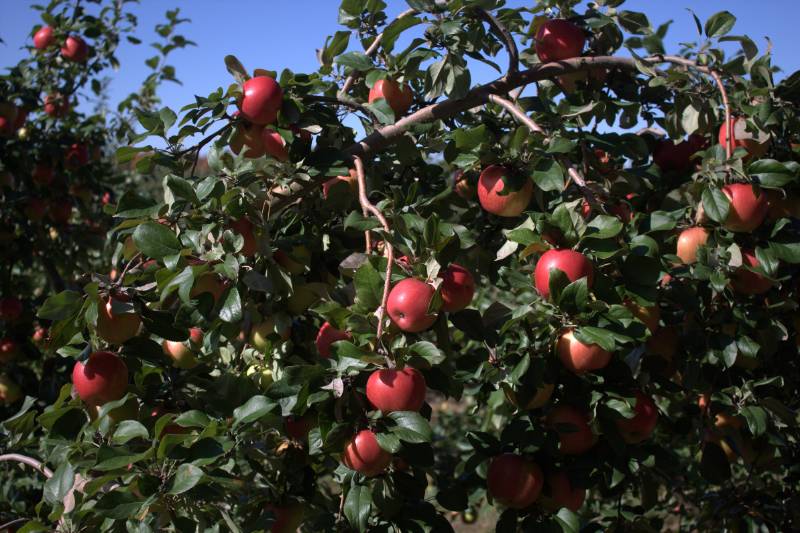
Honeycrisp Apple Tree – (Buy Online)
Honeycrisp Apple Trees have a taste that rivals even the great Fuji Apple, and they can be grown in your home garden. This apple was bred primarily for taste and its ability to grow in extreme cold. Unlike other commercial apples, the Honeycrisp wasn’t bred to grow, store, or ship well. But once people tasted Honeycrisp, the market demand for this delicious apple forced grocery distributors to find a way to get it onto store shelves.
With larger cells than other apples, Honeycrisp explodes with sweet juice when you bite into it. Beautiful skin is snappy, yet thin – a perfect complement to the crisp flesh – which has just the right balance between sweetness and acidity.
If you have had the pleasure of biting into a Honeycrisp apple bought at your local market, then the thought of that sweet tang and solid crunch is probably making your mouth water right now. But coming out of storage to be shipped to the grocery store does not provide the excellent flavor experience that comes from a fresh-picked Honeycrisp from your backyard. Imagine how that apple would taste fresh from your tree.
Sweeter, juicier, firmer, and just plain better! Plus, you have the added comfort of knowing just what went into (or didn’t go into!) those fresh eating apples before they appear on your family’s table.
A wonderful snack, each Honeycrisp apple has about 80 calories. These powerhouses also have pectic fiber, Vitamin A and C. Grow your own to eat clean. Congrats to the University of Minnesota for this delightful apple variety, another prizewinning introduction. Recent DNA testing indicates that the parentage includes Keepsake, Golden Delicious, and heirloom Duchess of Oldenberg varieties. This is such a successful variety in the more extreme cold climates of Growing Zones 3 and 4.
Gala Apple
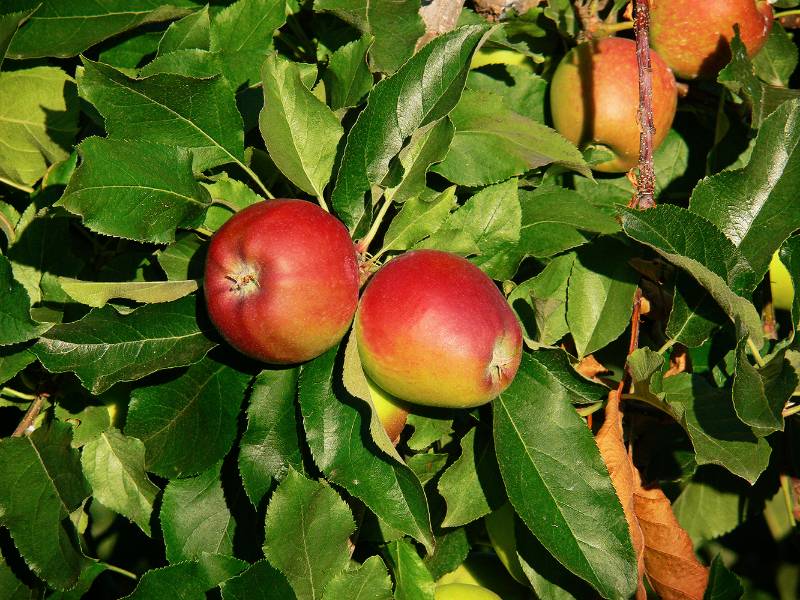
Gala Apple Tree – (Buy Online)
The Gala Apple (Malus ‘Gala’) Tree produces a delicious early-season snacking apple. The fruit is firm, juicy and sweet with a slight tart flavor. One of the very best early apples, Gala has a lot going for it. You’ll appreciate the precocious Gala Apple Tree because they are well-known to produce from a young age. Gala Apple Trees fruit young and ripen early – years before other apples. Homesteaders, urban foodies, and clean eating proponents alike can feel happy about the high fiber, antioxidants, and vitamins A and C found naturally in apples.
If you’ve ever considered growing a fruit tree, the Gala comes highly recommended. First developed in New Zealand, this great-tasting import produces large, crisp apples with rich flavor. Firm white flesh, a lovely floral fragrance, and a sweet, tangy snap. Hints of vanilla will make your taste buds smile.
In fact, Gala Apple Trees are in high demand around the world. Maybe it has something to do with the fact that they’ll start producing fruit as younger trees than other varieties. After all – who wants to wait for a harvest? Galas are also dependably productive, setting a great crop year to year. Although considered self-fruitful, in some zones a pollination partner is recommended.
Arkansas Black Apple
The Flavorful Arkansas Black Apple Tree is a late-maturing apple tree that bears fruit with a deep dark red color. One would be an outstanding addition to your yard in any sunny location where you can view it from one of your home’s windows…as you won’t want to miss a moment of your tempting harvest’s development.
The Arkansas Black Apple tree is not only lovely and hardy, but it also produces a substantial harvest of succulent, sweet apples.
The decorative effect of the dark red apples against the vibrant green of the foliage is not to be missed! Each round, medium-sized apple is such a deep red as to appear almost black, especially when stored.
The firm skin shines purple-red in the sunlight and tends to persist on the tree into the fall, making it a favorite of wildlife. As an eating apple, few can compare to the Arkansas Black. Exquisite directly from the tree, or used in a variety of dishes, the crisp, white/yellow flesh is superb.
With a sweet/tart flavor in a firm yet juicy texture, your Arkansas Black Apple is a treat for the senses. Especially prized for its aromatic nature, it also lends itself well to ciders and applesauce. Arkansas Black has an excellent storage life, affording you many months of enjoyment.
A semi-dwarf tree, your Arkansas Black will grow to about 20 feet in height. It’s quite hardy and vigorous, with particular resistance to Cedar Apple Rust. It has very good heat and humidity tolerance and is even somewhat drought tolerant once established. Arkansas Black is adaptable to a variety of soil types and has very good overall disease resistance.
Mutsu Apple
The Mutsu, or Crispin, Apple is a cross between Golden Delicious and Indo apple, a cultivar first grown in Japan. It is a large to very large, greenish-yellow to yellow apple with a conical shape with a sweetly tart flavor. Once you taste a Mutsu apple, you’ll wonder if you’ve ever really tasted an apple before. The Mutsu apple tree provides its bounty in September, and what a bounty it is! Crisp and juicy with an alluring hint of tartness, the Mutsu apple has a unique exotic flare. Some say the flavor is closer to apple cider than simply an apple itself.
Mutsu apples tend to be quite large; with a round shape and yellow coloration that has green tones. It has creamy white flesh and is delicious eaten right off the tree. It also is an excellent apple for baking, pies, sauces, salads, and long term storage. The Mutsu tends to be a prolific producer so you’re sure to have plenty of apples to share.
Mutsu apple tree will not only provide outstanding apples but is also an attractive tree for the home landscape. Spring flowers will adorn your tree with their subtle pinks and whites, drawing pollinators to your yard. Its vibrant, green leaves will present a lush, healthy appearance in your yard all summer long.
Winesap Apple
The Winesap Apple (Malus ‘Winesap’) is an heirloom Apple variety whose history dates from the 1700s, but the variety was further developed in the 1800s and became a fast favorite among growers big and small. It is still one of the leading strains being grown in the United States, and if you plant one (or 20), you’ll quickly see why Winesap Apples are also referred to as the “Stayman Winesap,” and is a prime choice for eating, juicing and baking.
Thought to be one of the juiciest varieties, the Winesap Apple is an all-purpose Apple you can slice for fruit trays and salads, turn by the handful into crisps and tarts, or even bake a classic Apple pie. This hardy fruit keeps for up to three months in cold storage, so you have lots of flexibility when it comes to preserving your annual harvest, whether you can your Winesap Apples, turn them into Applesauce and Apple butter, or choose to dehydrate them for enjoyment all year long.
Wolf River Apple
The Wolf River is also a beautiful apple, with a stunning, magenta blush against its yellow/green background and creamy white flesh. It has a sweet/tart flavor and holds its shape well with cooking. Wolf River is beloved for its use as a cooking apple, so you can use it in a variety of culinary delights. It’s a productive tree that will provide its luscious harvest in late September/early October. Wolf River has a spreading growth habit but is considered quite sturdy as well as hardy and long-lived.
If you enjoy apples, Wolf River is a great choice. Not only is it an excellent apple for eating and cooking, but it’s also a bit of a conversation piece. Friends and neighbors are sure to be impressed with the size of these apples, so they’re not only useful but fun as well.
Empire Apple
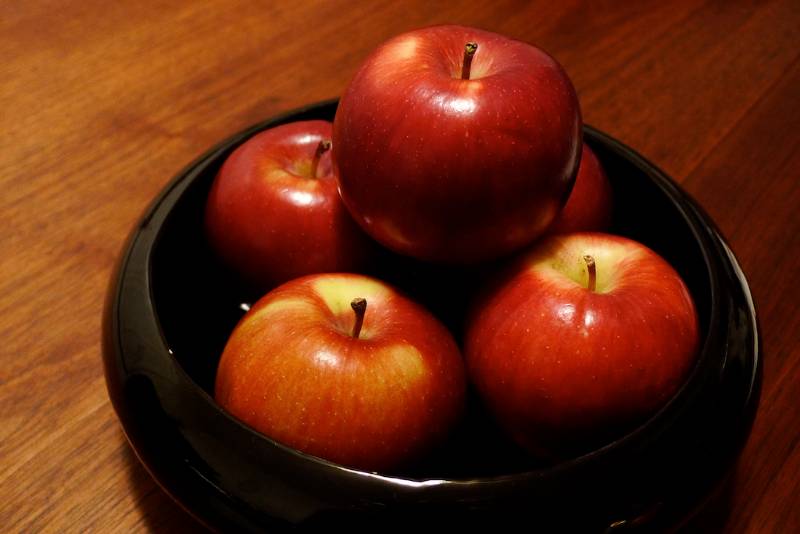
Empire Apple Tree – (Buy Online)
With the Empire Apple Tree (Malus ‘Empire’), you get the best two of the world’s most beloved apple varieties: the Red Delicious and the Macintosh. Because it offers the best characteristics of both of its parents, you know this is an apple that won’t remain in your bowl for long. Empire is an easy-to-grow apple tree that remains a steadfast favorite among growers. It offers longer-lasting fruit and a super sweet taste with a crisp snap of firm flesh inside.
You’ll praise the Empire’s crimson red skin and its dove white flesh, two of the attributes that make it a favorite among apple lovers. The taste is the one you remember from your childhood, sweet and desert-like, easily preferable to the snacks that you might reach for in the vending machine. Some fans say that the taste and its timeless scent beat out that of its parent, the McIntosh.This all-purpose apple is good for everything. It’s excellent as a snack for fresh eating, in fruit salads, minced into sauces, ciders, baking and it even freezes well. At maturity, this compact tree is sized just right for the suburban or urban garden, but you can keep it even smaller with a simple summer prune.
Braeburn Apple
The Braeburn Apple Tree is an ornamental tree that produces delicious fruit. Plant one for its decorative features in the front yard or several in a back or side yard to ensure a larger harvest. Braeburn apples are crisp and juicy. You’ll enjoy their sweet flavor combined with a tart edginess that brings out the one-of-a-kind tang that Braeburn exudes. They are medium to large, round apples that are yellow-green with red striping. They keep their quality for months in cold storage, so you can easily manage your harvest for future use.
Braeburn Apple trees can grow up to 15 feet tall with an equal spread. Its ornamental features are only second to the outstanding fruit production. White flowers appear in spring, followed by large apple mid-October. The production of both the fruit and flowers is prolific, providing an abundance of both bounty and beauty. The flowers will attract bees, butterflies, and hummingbirds. We take pride in delivering the highest quality plants with healthy roots and full, well-established stems and foliage.
Ginger Gold
The Ginger Gold Apple is an early-mid season ripening apple with exemplary qualities. Plant one in an open area away from buildings, but where you can enjoy watching its progress toward each year’s delicious harvest. The most popular feature of your Ginger Gold Apple tree is of course the fruit it produces.
Ginger Gold has become one of the most popular varieties of apple in recent years. Renown for its early-harvest and high quality, Ginger Gold Apple is stand-out among the apple varieties available today.
The Ginger Gold Apple is a lovely apple tree, beginning each spring with delicate white-pink blossoms. When your Ginger Gold truly shines, however, is in early-mid August. The large, conical apples start a pale green, but by mid-late August will mature to a lovely yellow-green, filling your tree’s branches with golden-hued fruit. The smooth, firm skin of your Ginger Gold will catch the afternoon light and draw you in for a taste of that sweet, creamy flesh. Its crisp texture makes this apple a delight to bite into, the taste enhanced by the mildly-tart essence that follows closely upon the initial sweet gush of flavor.
Zestar Apple
The Zestar Apple (Malus ‘Zestar’) is a relative newcomer; first being introduced in 1999 in Minnesota. With an exceptional balance of spicy-sweet flavor against the slight tang of its crisp, juicy flesh, Zestar has quickly established itself as a must-have for the Apple enthusiast. Zestar is not only delicious but also beautiful, with a bright red skin enhanced by delicate yellow/green highlights.
Zestaar Apples also have good storage life, lasting as long as 2 months with proper refrigeration. Zestar apple trees are cold hardy and one of the earliest to ripen. You’ll be picking apples as early as August!. Cortland is a recommended pollinator for your Zestar apple trees as well as any white blossoming crab apples. This early-ripening and long-storing apple will be a lovely addition to your home and offer you a harvest of delectable fruit for years to come.
Golden Sentinel
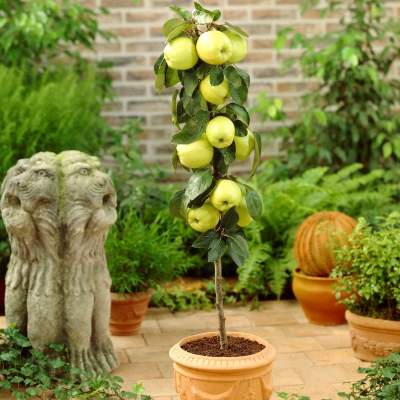
Golden Sentinel Columnar Apple
Can you imagine growing crisp, juicy, smooth, sweet, full-sized healthy apples in a lot less space? Now that’s a modern apple! Golden Sentinel (Malus domestica ‘Golden Sentinel’) is the columnar apple tree that you’ve been waiting for! This isn’t one of those wide, spreading apple trees that you’ve seen at your local orchard. This neat little cultivar grows vertically but stays compact and narrow. It’s covered in beautiful blossoms in spring, and then you get to watch the show.
Full-sized apples grow in clusters all along the tree trunk. Kids of all ages LOVE this tree! Grow it in large containers and prepare for the compliments and questions to roll in. You’ll love being on the cutting edge of the long-lived trend of using edible plants in both front and backyard landscapes.
Imagine a pair of these flanking your sunny entryway, or in large pots on the edges of your sunny balcony in the city. Or anchor a garden bed with a pair of these cute conversation-starters.
Just make sure you can reach to harvest the delicious golden-yellow apples! They ripen later in the season and often produce a crop the first year after planting.
North Pole
The North Pole Columnar Apple tree is going to be the talk of your neighborhood next year. We guarantee that you’ll be getting questions. Even though it is perfect for a small yard and container planting, it is traffic-stopping when planting in a large yard. This cute little cultivar was discovered several years ago and has become a sensation in the gardening world. It grows vertically and has no branching to speak of. The Apples grow in clusters on the tree trunk, looking very much like Brussels Sprouts growing.
You’ll be hard-pressed to find something as unique as this to grow in your garden! The Apples are large and red, very much like McIntosh Apples. They are a treat to eat fresh – deliciously sweet and juicy – but you’ll want to use it for baking and cider, too. They ripen in late August/early September and often produce a crop the first year after planting. These natural dwarfs. They need a pollinator but can be pollinated by any other Apple tree, so buy a pair for best fruit production. These grow well in large containers, which makes them perfect for sunny patios and balconies or any place without a lot of room for a full-sized fruit tree. They are striking in a large planter bed, too, surrounded by perennials and shrubs.
Golden Delicious
The Golden Delicious Apple tree (Malus ‘Golden Delicious’) is one of the world’s most widely planted apple trees and is one of the easiest and most dependable apple trees to grow.
In the spring, your Golden Delicious Apple tree will burst into bloom. Beautiful clusters of pink buds open to reveal snowy white flowers.
From September to October, your Golden Delicious apples will turn from a pale green to their familiar golden-green color, signaling that they are ripe.
When Golden Delicious Apples are allowed to ripen on the tree, you will notice a vast difference in flavor when compared to the Golden Delicious apples purchased at the supermarket.
Homegrown Golden Delicious apples are exceptionally sweet and rich. Their thin skin and delicious crisp fruit make the Golden Delicious a favorite for eating fresh off the tree and for baking.
Fireside Apple
Fireside Apples (Malus ‘Fireside’) have been a staple in bakery pantries since 1943, so they have stood the test of time as the perfect apple for sweet dessert dishes.
This easy-to-grow apple tree is enjoying a resurgence in home gardens because of its sweet taste and because it doesn’t even shudder at bitter-cold winters. (It is a Minnesota native after all.) They ripen in early October right when a gooey apple crisp would be so welcome as you warm up by the fire. (Maybe that’s where the name came from?) These firm, red-speckly-skinned apples are medium-sized and easy to pick.
They eat great fresh-out-of-hand too with their juicy-sweet taste so they make for great family picking in the fall. The tree itself is perfectly-sized for the backyard garden, but it does need a pollinator to produce at its best. You’ll want to pick another early or mid-season variety like Honeycrisp, Jonathan, or Golden Delicious. Give it full sun and lots of water and you’ll be enjoying fresh apples before you know it.
Snowsweet
Nothing makes a fresh-fruit salad look as unappetizing as browning apples in the mix. Now we have Snowsweet Apple Tree (Malus domestica ‘Snowsweet’ ) to the rescue!
This relative new-comer on the orchard scene (developed in 2006 at the University of Minnesota) was developed to have snow-white flesh that stays crisp and resists oxidizing (turning brown) long after you slice it. No more waiting until you get to the party to slice up the apples at the last minute! It stores for a long time too – 2 months or more!
The beautiful fruit is classic apple-red so it looks as appetizing as it tastes. The tree is as beautiful as the fruit it bears, too. It is very open but has a slight ‘droop’ that gives it a very romantic look in the home landscape.
The sweet fruit ripens in September. This is a great northern apple tree where it survives hard winters without a problem. For best yields, you’ll want to pick another early or mid-season variety like Empire or Red Delicious to plant with it as a pollinator.
Cortland
The Cortland Apple Tree (Malus ‘Cortland’) is a cross between McIntosh and Ben Davis with the best qualities of both. It is one of the very few self-pollinating apple trees.
Cortland Apple Trees bloom midseason with a dazzling show of pink buds and snowy white blossoms. It’s a beautiful display, and a sign of the delicious apples to follow.
The Cortland Apple Tree fruits annually. Its harvest is heavier than most apples, and the apples are ready to harvest in September and October, just in time for a warm apple pie on a cool, crisp fall day.
The apples from a Cortland Apple Tree are juicy and sweet with a slight hint of tartness at their peak. It is a large brilliant red-striped apple with stark white, tender flesh. Amazingly, the flesh retains its clear white color after slicing making it a wonderful choice for salads and fruit trays.
Niedwetzkyana Apple

Organic Heirloom Niedwetzkyana Apple Tree
The Niedwetzkyana Organic Heirloom Apple, Malus domestica ‘Niedwetzkyana’, is a large bright red apple with brilliant red flesh. The flavor is balanced between sweet and tart, and it gets sweeter if left on the tree longer. Maturing on a vigorous growing tree and having an excellent storage life, these apples ripen at the end of September in most locations. The Niedwetzkyana apple makes a great apple pie and it resembles the pies made from cherries. It is also good for fresh eating, desserts, cooking (puree, applesauce, apple butter), baking, juice, and hard cider. This tree will present the most striking fall colors!
Hudson’s Golden Gem

Hudson’s Golden Gem Apple Tree – (Buy Online)
Hudson’s Golden Gem has become a first choice for fresh eating and for cider and juicing. They are one of the best tasting apples around, period. And they’ll store in your refrigerator for months.
This was a chance seedling discovered at the Hudson Nursery of Tangent Oregon in 1931, and now a prized heirloom variety with outstanding flavor. As with other russet skinned apples, the old fashion pear flavor jumps out with a sugary-sweet, nutty richness. Hudson’s Golden Gem is an annual-bearing fruit, so you can depend on a good crop each year.
It has excellent resistance to common apple diseases. Pollinate with any early to mid-season apples in Hardiness Zones 7-9, and with mid-season blooming selections in Hardiness Zones 4-6. Hudson’s Golden Gem can also be pollinated with Dolgo Crabapple. For successive backyard harvests, plant with an early ripening McIntosh and a Yellow Newtown Pippin. You’ll enjoy fruit all season long. Add one or more Hudson’s Golden Gem Apples to your edible landscape. It will become one of your most prized varieties.
Crunch-A-Bunch Apple
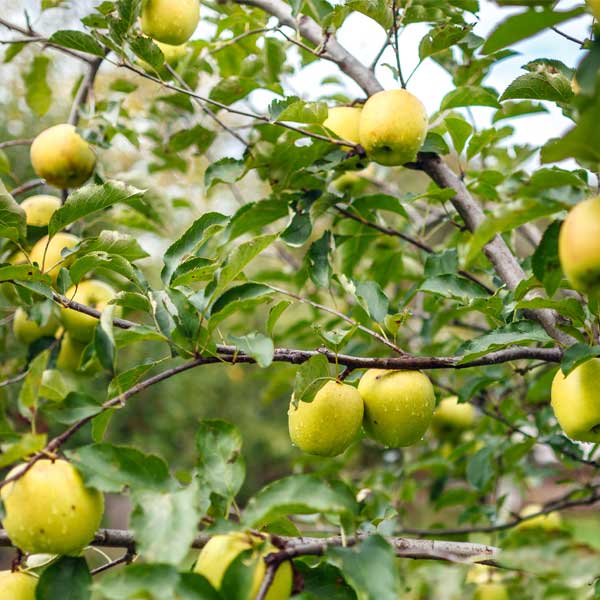
Crunch-A-Bunch Apple Tree – (Buy Online)
The Crunch-A-Bunch™ Apple Tree (Malus ‘4-10’ PP29126) was developed by the Midwest Apple Improvement Association (MAIA) to beat the late season frosts.
Whenever Honeycrisp Apple is involved in as a pollination parent for an Apple hybrid, you know that the fruit is going to be great. Crunch-A-Bunch is a yellow Apple variety with great texture and flavor.
It shows excellent productivity. The apples hang on the tree well for an easy, convenient harvest.
You’ll certainly appreciate the yummy taste of these well-balanced apples. The sweet tart flavor hints of tropical pineapple and is perfect for snacking, baking and cider.
Crunch-A-Bunch produces very crunchy apples that do not turn brown after being cut. The unique pineapple or tropical flavor draws kudos from everyone who tries it.
Selected the winner in multiple blind tests, you won’t believe how juicy they are! The skin is nice and tender, but the texture is light and very crisp.
Highly productive Crunch-A-Bunch has opened the door to a whole new flavor profile. Best of all, the abundant fruit set of glowing, round golden apples will keep for up to 8 months in refrigeration!
Crunch-A-Bunch is destined to be a backyard orchard favorite. We have a limited supply of these trees. Don’t miss the harvest that ripens to perfection in mid-September and keeps until the following summer.
Summerred Apple

Summerred Apple Tree – (Buy Online)
The Summerred Apple Tree (Pyrus communis ‘Summer Crisp’) is a reliable producer and it’s a wonderful variety for climates with cool summers. Backyard orchards in the Pacific Northwest should include this hot variety!
Hybridized in British Columbia from Mcintosh and Golden Delicious parents, Summerred produces dark red, oval fruits. The flavor is reminiscent of Golden Delicious, but a bit more robust and full-flavored.
These early ripening apples are great for fresh eating and baking.
The fruit also stores well! Summerred is a hardy selection that shows some resistance to apple scab in many areas. You’ll need to plant a partner tree for pollination. People have been snapping up our Summerred Apple trees like hotcakes. The red fruits have a fine eating quality. They are excellent for fresh eating, but are firm enough to hold up to baking. The juicy fruit is well-balanced and features hints of strawberry. Use these special apples as part of a dessert tray with an assortment of artisan cheeses.
Summerred is also an attractive tree in its own right. With snowy white spring blooms and highly ornamental red fruit, you’ll be tempted to use it as a focal point in an Edible Landscape.
Chehalis Apple
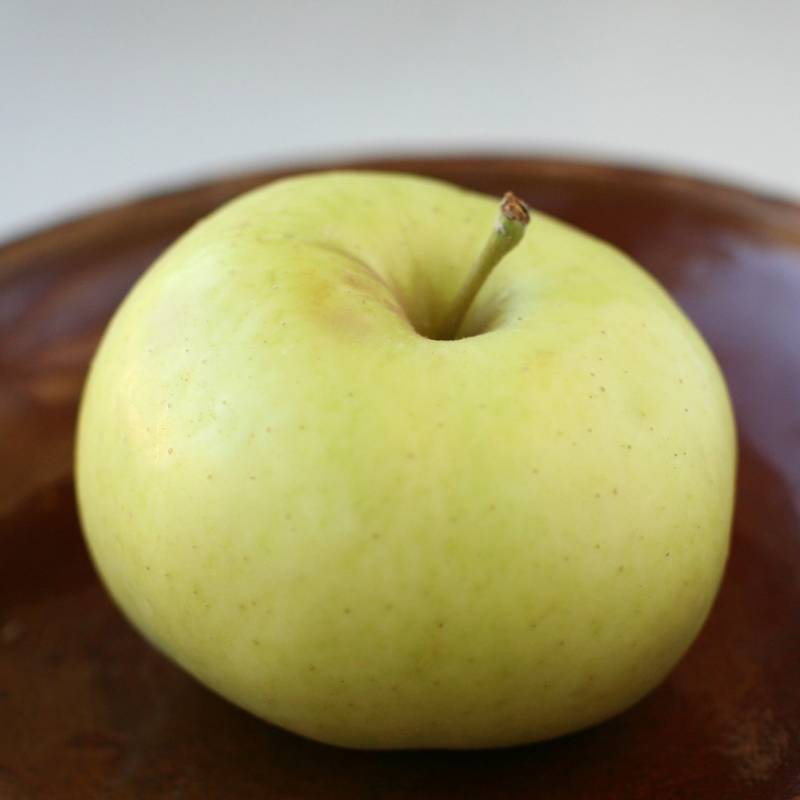
Chehalis Apple Tree – (Buy Online)
The marvelous heirloom, Chelalis Apple (Malus domestica ‘Chehalis’) produces large, greenish-yellow apples with an occasional pink blush. These crisp apples are great for fresh eating, baking, and cooking. They are versatile, as the flavor turns from mildly tart to sweet depending on when you pick them. Lift them up to test for ripeness. If they pop off easily in your hand, they are ripe and will be sweeter.
For pie apples, consider harvesting a bit earlier. Blend them with other tart apples in fantastic pies. Pick them when ripe for a sweeter, sub-acid treat. Or, allow them to sit for a few days to soften for applesauce. No need to add sugar!
Melrose Apple
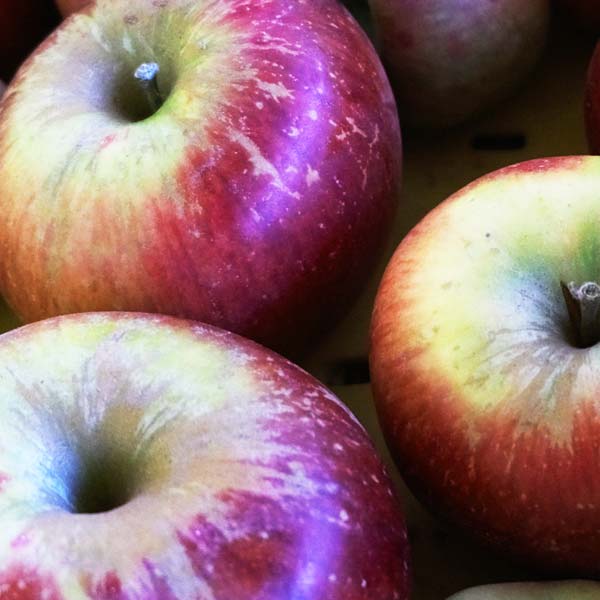
Melrose Apple Tree – (Buy Online)
The Melrose Apple tree (Malus ‘Melrose’) is beloved for its flavor. With russeted yellow and green skin, and fiery red streaks, these apples are a huge hit at farmer’s markets. Why not grow your own for a plentiful supply of this cherished variety?
These long-keeping apples taste amazing, long into wintertime! The pretty creamy flesh is firm and juicy and features a wonderfully fruity aroma. The flavor is well-balanced, with a slightly acidic zip to bring out the full complexity of the fruit sugars.
Use them for sauces, baking, on fruit and cheese trays, and as an eating apple from January through April. Melrose is a great value, as the productive tree provides for you and your family.
This tree is an annual bearer. Let the fruit hang on the tree, or pick and store in a cool, dry place. They’ll store in your refrigerator for months. As with other russet skinned apples, the flowery aroma and flavor features a nutty, sugary richness.
Tasty Red Urban Apple
Few things are as American as apple pie. Unfortunately, few of us have space in our yards for an apple orchard or even an Apple tree. Tasty Red Urban Apple, Malus domestica x ‘UEB 3449-1, is going to change that! This is not your typical Apple tree. Staying small and narrow only 2 feet wide. That means that this tree is perfectly sized for urban gardens. It grows well in a bed and excels in a large container. In the spring the ramrod-straight branches are covered in romantic, sweet-scented, Apple blossoms. In the fall they are covered in full-sized delicious Apples nestled along the limbs of the tree like Brussels Sprouts.
Imagine being able to pick full-sized Apples straight from your patio or balcony! This isn’t some Apple-pie-in-the-sky dream either. These Apples will grow the first year you plant the tree and only have higher yields every year after that! These beauties need a pollinator so plant “Tasty Red” with its sister “Tangy Green Urban Apple” in twin containers on the patio, flanking the entrance or in the garden bed. You’ll double the yield and double the fun! It’s hard to believe but true. You can grow Apples in any sized garden – even on your balcony – with the new Urban Apples. Order yours today and see for yourself! Very Easy Care Only Two-Foot Wide – No Pruning Full-Sized Sweet, Juicy Fruit Spring Flowers!
Tangy Green Urban Apple
Ok. We’ll admit it. It looks a little weird. Apples growing along the limbs of a tree that is only two-feet wide? But once you see it…and then taste it…you’ll see how ingenious the new Tangy Green Urban Apple truly is! Tangy Green Urban Columnar Apple, Malus x domestica ‘AK – 98’, is the solution to having normal sized Apples in smaller urban gardens, on balconies and even in pots.
Staying shorter and only two-feet wide, Tangy Green gives huge Apple yields in about a square foot. This makes it perfect for containers and small spaces. You’ll have beautifully romantic Apple blossoms in the spring followed by full-sized tart green baking Apples in the fall, so plant these petite trees where you can enjoy the flowers and fruit easily.
Tangy Green will grow and set fruit the first year you plant it and only have higher yields year after year! For best crops, a pollinator is needed so plant “Tangy Green” with its sister “Tasty Red Urban Apple” in containers on the patio, by the front door, or in your urban orchard. Double the yield, double the fun! Embrace the weird! Grow full-sized Apples in any sized garden – even on your balcony.



